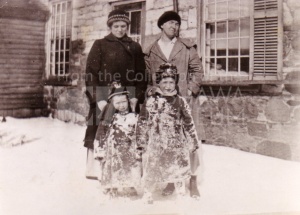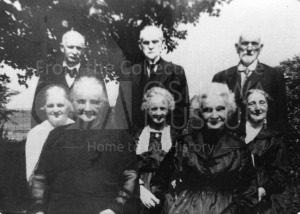By Lisa Terech, Community Engagement
While on tour, our Visitor Hosts are often asked questions that they may not be able to answer in that moment. However, we take note of the questions and try to find the answers afterwards. Here is a sampling of the questions our Visitor Hosts were asked through the summer of 2023!
The mesh hanging piece in Henry House kitchen (by the summer kitchen) and what it was used for?
This has “bee”n an object featured in our popular What is it Wednesday series because it truly is a curious piece. “Bee”-lieve it or not, it’s a bee trap or fly catcher. The idea is the pest can fly in (and adding some fruit or another lure would help as well) but cannot fly out.
What did Thomas Henry farm?
The 1851 Agricultural Census gives us insight into this answer. That year, it was recorded that the Henrys has 120 acres, 90 of which were under cultivation.
57 acres were under crops, broken down as follows:
- 40 acres wheat
- 1 acre peas
- 14 acres oats
- 2 acres potatoes
83 acres were under pasture, and 15 acres were under wood or wild. Now, I realize that adding all these numbers together don’t add up to the numbers above, but this is how it was recorded in 1851.
In addition, he had livestock on his farm, including:
- 4 bulls, oxen or steers
- 4 milch cows (a cow in milk or kept for her milk)
- 3 cows
- 3 horses
- 27 sheep (with 100 lbs of wool)
- 7 pigs
Finally, it was noted that the farm had 10 bundles/tons of hay and 100 lbs of butter (and with cows being kept for milk, a good amount of butter makes sense)!
What is the tool on the wall beside the oven in Henry? Looks like a carpet beater?
It is a carpet beater!
When was the Lady of the Lake statue put in?
The Lady of the Lake was controversial in the 1959 when she was unveiled in Lakeview Park as many didn’t like their tax dollars being spent on a statue who was not wearing any clothing! To learn more about the statue, the controversy, and how it’s moved around in the park, please visit our online exhibit about Lakeview Park: https://lakeviewparkoshawa.wordpress.com/2020/05/21/the-lady-of-the-lake/
Was the well ever too dirty?
Excellent question, and, sadly, not one we can answer with certainty. We don’t have information in the archives about the state of the well, and we have yet to determine where the family would have had their well. We’ve been lucky to host students from Trent University Durham on three occasions. In 2018, the archaeologist, Dr. Helen Haines, felt confident in saying we likely found the midden (garbage pit), found just to the north of the house. Still to be found are the locations of the (probable) well and the location of the privies. So, we cannot say for certainty whether or not the well was ever unviable. Luckily, the family did live within a stone’s throw of Lake Ontario!
What can you tell us about the light fixture in the dining room of Henry? And, another visitor asked, Is the chandelier original?
None of the light fixtures are original to the house. In fact, the light fixture in the dining room, many years ago, would have been a gas fixture. It has since been retrofitted to electric. And, of course, all of the electric lights are our modern convenience for Henry House, one that the Henry family would not have enjoyed when they lived in the home in the 1800s!














